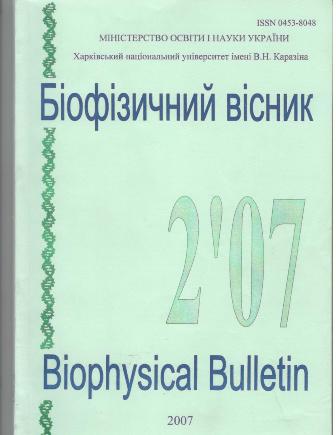The influence of pH on the electrical properties of bovine serum albumine
Abstract
The influence of pH on the electroconductivity of bovine serum albumin (BSA) solutions has been studied. It was shown that the bulk conductivity of electrolyte ions makes the main contribution to the disperse system conductance for BSA solutions at рН 2,63 and 6,15 in the temperature range from 5 to 40°С. At temperatures of 23-33 °С and рН 3.6 and 7.4, the value of electrical conductivity of the BSA solutions were found to be smaller than that for buffer. An increase in temperature was found to result in a faster increase of conductance of BSA than that of the buffer. This effect was interpreted in terms of the increased contribution of the surface conductivity of a double ionic stratum. The conductance of BSA at isoelectric point (рН=4,6) essentially exceeds the conductance of buffer solution at the same value of рН. This phenomenon was suggested to stem from the proton conductivity on a surface of protein molecules connected with lowering the protein hydration up to a critical level.
Downloads
References
Сячинова Н.В., Танганов Б.Б. Теоретическое и экспериментальное определение электропроводности и вязкости желатина и продукта растворения коллагена. // Материалы международной научной конференции «Химия, химическая технология и биотехнология на рубеже тысячелетий» - г. Томск, Россия. - 11-16 сентября 2006 г. С. 127.
Huang Y., Wang X-B., Tame J.A., Pethig R. Electrokinetic behavior of colloidal particles in traveling electric fields: studies using yeast cells. // J. Phys. D: Appl. Phys. - 1993.-V. 26. - P. 1528-1535.
Духин С.С. Электропроводность и электрокинетические свойства дисперсных систем. Киев: Наукова думка, 1975. - 346 с.
Челидзе Т.Л., Деревянко А.И., Куриленко О.Д. Электрическая спектроскопия гетерогенных систем. - Киев: "Наукова Думка", 1977. - 232 с.
Suhcrman P.M., Tylor P., Smith G. An investigation of water/protein interactions from temperature dependent dielectric properties. // British Pharmaceutical Conference. - 2001. - Abstract Book. - P. 30.
Suherman P.M., Smith G.A. percolation cluster model of the temperature dependent dielectric properties of hydrated proteins. //J. Phys. D: Appl. Phys. - 2003. - V. 36. - P. 336-342.
Хамидуллин Р.М., Зуев Ю.Ф., Вылегжанина Н.Н. Влияние этиленгликоля на структуру обратной мицеллы АОТ с солюбилизированным в ней трипсином. Исследование методами ЭПР спиновых зондов и электропроводности. // Структура и динамика молекулярных систем. - 2003. - Выпуск X, часть 2. - С. 71-74.
Иоффе В.А. Диэлектрическая спектроскопия: Москва, Издательство иностранной литературы. - 1960. - 362 с.
Соркина Д.А., Залевская И.Н. Структурно-функциональные свойства белков. - К.: "Высшая школа". - 1990. - 495 с.
Фридрихсберг Д.А. Курс коллоидной химии. - Л.:Химия, .1974. - 352 с.
Антонченко В.Я. Физика воды. Киев: "Наукова Думка". - 1986. - 128 с.
Попко К.К., Дейнега Ю.Ф., Ковчанин Н.Я. // ДАН УССР. - 1971. - Т. 10. - С. 921.
Глесстон С. Введение в электрохимию. ИЛ., 1951. - 200 с.
Якубке Х.-Д., Ешкайт X. Аминокислоты. Пептиды. Белки: Пер. с. нем. - М.: "Мир", 1985. - 456 с.
Authors who publish with this journal agree to the following terms:
- Authors retain copyright and grant the journal right of first publication with the work simultaneously licensed under a Creative Commons Attribution License that allows others to share the work with an acknowledgement of the work's authorship and initial publication in this journal.
- Authors are able to enter into separate, additional contractual arrangements for the non-exclusive distribution of the journal's published version of the work (e.g., post it to an institutional repository or publish it in a book), with an acknowledgement of its initial publication in this journal.
- Authors are permitted and encouraged to post their work online (e.g., in institutional repositories or on their website) prior to and during the submission process, as it can lead to productive exchanges, as well as earlier and greater citation of published work (See The Effect of Open Access).





